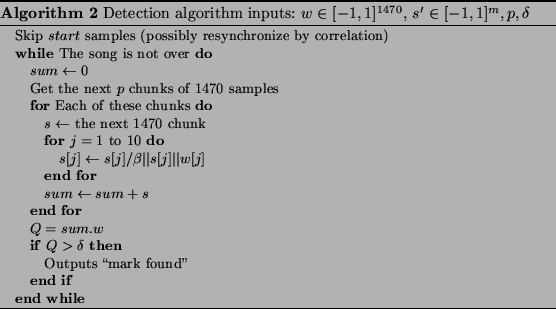![\begin{algorithm}
% latex2html id marker 112\caption{Marking algorithm:
inputs...
...ert w[j]$}
\ENDFOR
\STATE{Output $s$}
\ENDWHILE
\end{algorithmic}\end{algorithm}](img35.png)
![\begin{algorithm}
% latex2html id marker 112\caption{Marking algorithm:
inputs...
...ert w[j]$}
\ENDFOR
\STATE{Output $s$}
\ENDWHILE
\end{algorithmic}\end{algorithm}](img35.png)

Let us now briefly explain why we believe the detection algorithm works this way. The embedded mark is very small. It is actually a noise compared to the signal of the song. The standard technique to detect a noise embedded in a signal is correlation. However, one needs to correlate on a long enough chunk so that the noise correlation is much larger than the correlation of the signal and the noise.
Consequently, correlating on ![]() samples is not enough to reveal
the presence of the mark. This is why we are actually correlating on
the average of
samples is not enough to reveal
the presence of the mark. This is why we are actually correlating on
the average of ![]() chunks of
chunks of ![]() samples.
samples.
We have tested the detection algorithm with two different sizes of ![]() ,
,
![]() (one correlation per second) and
(one correlation per second) and ![]() (one correlation every
(one correlation every
![]() seconds, the maximum detection time required by the original SDMI call
for proposals). The results are given in section 6.
seconds, the maximum detection time required by the original SDMI call
for proposals). The results are given in section 6.